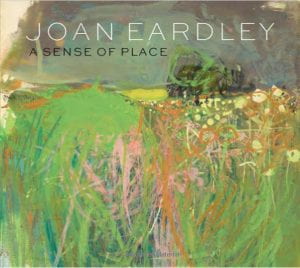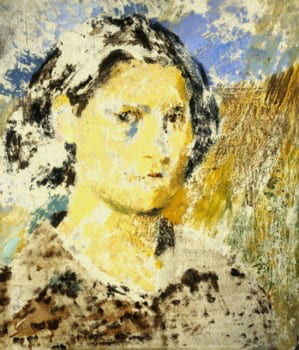
Joan Eardley’s 1943 prize-winning self portrait at Glasgow School of Art – seen as the precursor to her powerful and enduring social portraiture of children in the Townhead area of Glasgow. Included for criticism and review.
The Times newspaper called Joan Eardley (1921-1963) one of Britain’s ‘pre-eminent artists of the 20th century.’
The Guardian says she is:
“…the forgotten artist who captured Scotland’s life and soul, children from Glasgow’s slums, bleak seascapes, village fishermen at work … the vibrant visions of Joan Eardley are finding a new following.”
In recent years Scotland has staged major exhibitions of her work in Glasgow and Edinburgh.
She is now the focus for the hugely popular exhibition ‘Joan Eardley: A Sense of Place’ at the National Galleries of Scotland in Edinburgh until 21st May.
Public demand is so great the National Galleries have extended opening times until 8 p.m. for the final weekend.
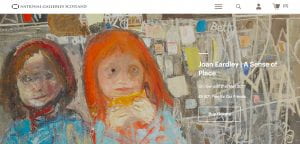
Exhibition ‘Joan Eardley: A Sense of Place’, Featuring Image: Children and Chalked Wall 2, 1963 Abbot Hall Art Gallery, Kendal © Estate of Joan Eardley. All Rights Reserved, DACS 2016
At the time of writing a new stage play, Joan Eardley: A Private View, is on national tour celebrating and exploring her life and contribution to the world of art.
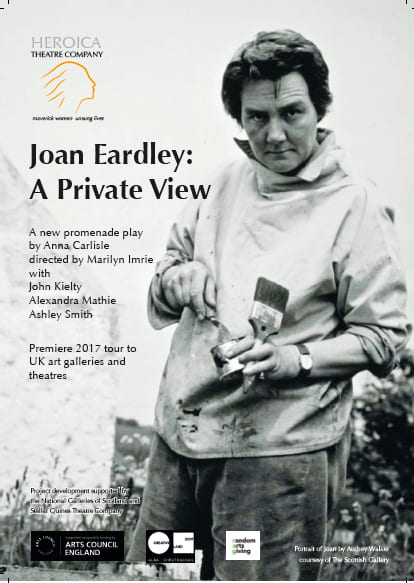
Click through for links for booking touring performances. Worth ordering ahead as venues are selling out quickly.
The production by the Heroica Theatre Company has been written by Anna Carlisle, and is being directed and performed by some of the most respected figures in Scottish drama.
Joan’s critical reputation is largely based on her characterful and figuratively human portraiture of street children in Glasgow and for her evocative landscapes of the fishing village of Catterline and surroundings on the North-East coast of Scotland.
Sense of Place curator Patrick Elliott describes her Glasgow children paintings as ‘candid’, and her Catterline landscapes as full of ‘leaden skies and wild sea.’
What is less well known is that Joan was enrolled at Goldsmiths Art School during the autumn term 1938 and spring term 1939 – before moving to Glasgow School of Art where in 1943 she won the Sir James Guthrie Prize for portraiture for her remarkable self-portrait featured at the top of this article.
She came to south east London as a result of profound family tragedy.
In 1929, when she was only seven, her father, a veteran of the Great War and severely afflicted by the effects of a gas attack, took his own life when experiencing failure as a dairy farmer.
Her mother moved Joan and her younger sister back to the family home in Blackheath, London, to live with their grandmother and aunt.
They were able to afford to send Joan to a local private school and then a local art school.
She enrolled at Goldsmiths in the autumn of 1938 with the backdrop of the turbulent drama of Munich and the fear of war.
Her two terms at New Cross tend to be overshadowed in the biographical narratives by her undoubted achievements in Scotland.
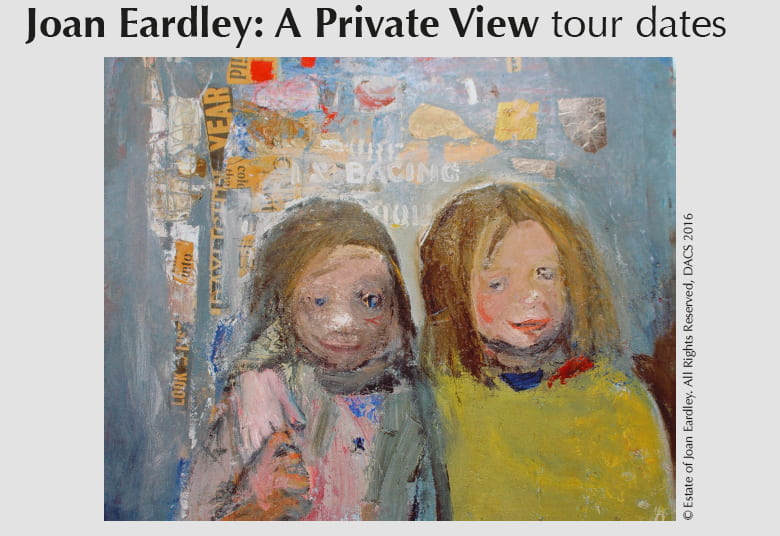
Joan Eardley: A Private View is on a national tour beginning in Scotland during May and moving to Scarborough, Huddersfield, Halifax, London, Reading and Coventry in June.
Hitler’s ruthless takeover of Czechoslovakia in the spring of 1939 defied all the promises of ‘peace in our time’ and the impending storm of global war meant her time at Goldsmiths was cut short.
Joan’s style is largely attributed to being under the influence of Hugh Adam Crawford in Glasgow and the Scottish Colourists.
But when she was at Goldsmiths, the Art School was under the direction of the progressive and highly respected Clive Gardiner who had been appointed headmaster in 1929, the very year Joan moved to London.
As an artist, particularly in terms of the public realm, Clive Gardiner’s style is powerfully driven by bright and vibrant colour.
‘White City in Harringay Park’ is a striking poster design referencing cubism, modernism and rich in modern Art Deco colour from 1927 and is in a unique collection curated by the Transport Museum in London.
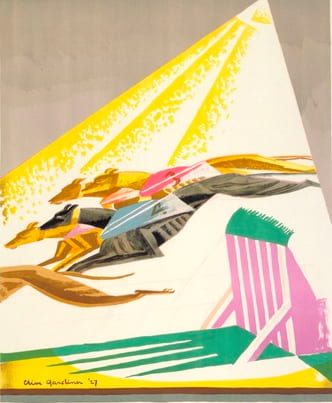
White City, Harringay Park, by Clive Gardiner, 1927 Published by Underground Electric Railways Company Ltd. Copyright: Transport for London. Included for criticism and review.
Clive Gardiner was also in great demand as a portraitist.
Does his self-portrait, held in the Goldsmiths Art Collection, have any coincidence with Joan Eardley’s famous award-winning self-portrait?
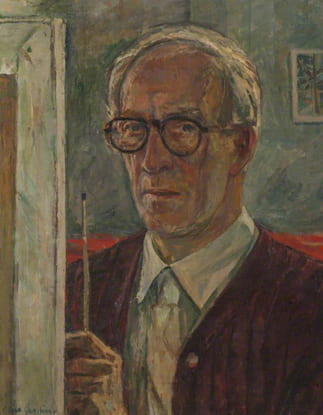
Clive Gardiner A Self-Portrait. The Goldsmiths Art Collection.
Graham Sutherland repeatedly credited Clive Gardiner for modernising Goldsmiths Art School, and being a huge source of inspiration for the students there during the 1920s and 30s.
He once said: ‘Everything worthwhile I learnt, I learnt from him.’
Clive was inspired by his love of Cezanne, Derain and Picasso, and his enthusiasm for the avant-garde breaking new ground in Europe.
He advised his students to respect commercial art and design as being the equal to fine art.
The London Transport museum collection of his poster art is distinguished by a style and engagement with colour similar to the Scottish colourist movement.
And at the same time Joan Eardley began her studies at Goldsmiths, Clive Gardiner was working on murals for the 1938 Glasgow Empire Exhibition.
The play Joan Eardley: A Private View is being performed at the London Omnibus, Clapham Common, on Monday 5th June and The Caledonian Club, London on Wednesday 7th June.
The book accompanying the exhibition Joan Eardley: A Sense of Place written by Patrick Elliott and Anne Galastro combines excellent criticism with biography.
Other impressive critical books on Joan that are recommended for further reading and are beautifully illustrated include Joan Eardley by Fiona Pearson (2016) and Joan Eardley by Christopher Andreae (2013).
Joan Eardley was elected a full member of Royal Scottish Academy in 1963, the year of her untimely death from cancer.
It may well be the case that Joan’s time at Goldsmiths Art School in 1938-9 carried a greater influence on her development as an artist than has perhaps been realised.
Whether it did or not, the considerable recognition of her significance as an artist and the creative dramaturgy of the touring play about her life offers a delightful prospect for synergy in the new Goldsmiths Gallery being developed as a result of generous support from alumni.
That’s So Goldsmiths– a forthcoming history of the university is being researched and written by Professor Tim Crook.
Goldsmiths History Project Podcast by Professor Tim Crook
